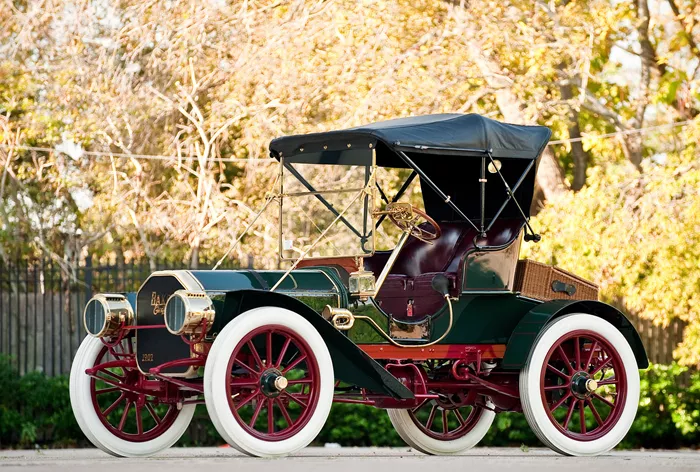The Baker Electric car is one of the pioneering electric vehicles in the history of the automobile industry. It was created in the early 20th century, a time when electric cars were competing with gasoline and steam-powered vehicles. The Baker Electric is a testament to early innovation in electric cars and reflects the evolution of electric cars as a viable form of transportation.
History of the Baker Electric Car
The Origins and Early Development
The Baker Motor Vehicle Company was founded by Walter C. Baker in 1899 in Cleveland, Ohio. The company specialized exclusively in producing electric cars during a period when the automotive industry was still in its infancy. The Baker Electric quickly gained a reputation for reliability, quiet operation, and ease of use.
At the turn of the 20th century, electric vehicles were favored in urban areas due to their lack of noise, fumes, and vibration compared to internal combustion engine vehicles. The Baker Electric was among the most popular electric vehicles in the United States from 1900 to 1916.
Significant Milestones
Throughout its production years, the Baker Electric car was known for its luxury and craftsmanship. The company offered various models, including runabouts, sedans, and town cars. By 1910, the Baker Electric was considered a premium electric car brand, favored by many wealthy individuals and even celebrities.
One of the most famous owners of a Baker Electric was Clara Ford, wife of Henry Ford. This highlighted the car’s status and acceptance among the elite. However, the rise of the gasoline-powered car, especially after the introduction of the affordable Ford Model T, gradually reduced the demand for electric vehicles.
Decline and Legacy
The Baker Motor Vehicle Company ceased operations around 1916 as the gasoline engine dominated the market. Despite its decline, Baker Electric left a legacy as a pioneer in electric mobility and influenced later developments in electric cars. The historical importance of the Baker Electric is remembered by car enthusiasts and historians alike.
Characteristics of the Baker Electric Car
Design and Build Quality
The Baker Electric car was known for its elegant design and solid construction. Most models had a classic carriage-like appearance with smooth, rounded lines. The body was often crafted with high-quality wood and metal, showcasing skilled craftsmanship. This design made the car look both luxurious and practical for its time.
Electric Powertrain
Powered by electric motors, the Baker Electric used a rechargeable battery pack, typically composed of lead-acid batteries. These batteries were heavy but offered a quiet and smooth ride. The car’s electric motor delivered a steady torque, making acceleration smooth but not very fast compared to modern standards.
Performance and Range
The Baker Electric car had a top speed of around 20 mph (32 km/h), which was adequate for city driving at the time. The driving range per charge was approximately 50 to 80 miles, depending on conditions. This range was competitive compared to other electric vehicles of that era but limited compared to gasoline-powered cars.
Charging and Operation
Charging the Baker Electric was done by plugging into an electric power source, usually at home or specialized stations. Charging times varied but were generally longer than the refueling times of gasoline cars. Despite this, many owners appreciated the simplicity of operation and the quiet, clean nature of the vehicle.
Comfort and Features
Luxury features in some Baker Electric models included plush upholstery, brass fittings, and ample passenger space. The cars were designed for comfort, focusing on a smooth and silent ride. The driving controls were simple, often with a tiller steering system or early steering wheels, making the vehicle easy to handle.
Price of the Baker Electric Car
Price Range in Historical Context
When introduced, the Baker Electric car was considered a luxury item. Prices ranged from $1,750 to $3,000 in the early 1900s. Adjusted for inflation, this would be equivalent to roughly $50,000 to $90,000 today, positioning the car as a premium product.
Factors Affecting Price
The price reflected the quality of materials used, the craftsmanship involved, and the exclusivity of electric technology at the time. The Baker Electric was targeted mainly at affluent buyers who valued luxury and innovation.
Comparison with Competitors
Compared to gasoline cars such as the Ford Model T, which cost under $1,000 by the 1910s, the Baker Electric was expensive. This price difference contributed to the limited market reach of the Baker Electric car. However, its price was justified by its unique electric powertrain and refined build quality.
Performance of the Baker Electric Car
Driving Experience
The Baker Electric offered a quiet and smooth driving experience. Without the noise and vibrations of combustion engines, the car was comfortable for short urban trips. The instant torque from the electric motor made starting from a stop easy, although acceleration was modest by today’s standards.
Range and Battery Life
The battery technology of the time limited range and battery lifespan. Lead-acid batteries required regular maintenance and careful handling to ensure longevity. Despite these limitations, the Baker Electric was reliable within its operational range and had a respectable range for city driving.
Reliability and Maintenance
The Baker Electric was easier to maintain than gasoline cars, as it had fewer moving parts and no engine oil or fuel systems to manage. This simplicity made it popular among owners who wanted a low-maintenance vehicle. However, battery upkeep and charging infrastructure were challenges.
Influence on Modern Electric Cars
The Baker Electric set a precedent for modern electric cars by demonstrating the feasibility of electric propulsion. Today’s electric cars models benefit from advanced battery technology and enhanced performance but owe much to early pioneers like the Baker Electric.
Conclusion
The Baker Electric car represents a significant chapter in automotive history. It was an early example of innovation in electric mobility, combining luxury, craftsmanship, and a clean energy drivetrain long before the current rise of electric vehicles. Although the company ceased operations over a century ago, the principles behind the Baker Electric continue to influence the development of modern electric cars.

